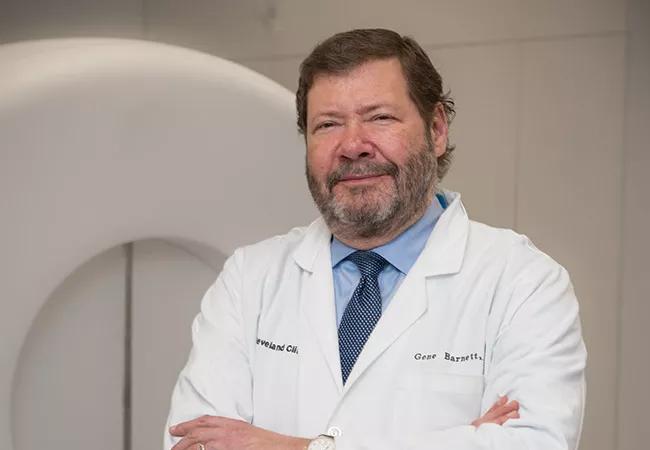Plus advice on finding the gravesite of Dr. Harvey Cushing

Since 1999, Cleveland Clinic, through its Gamma Knife Center, has been one of a handful of institutions to offer continuing medical education (CME) in the use of Gamma Knife® stereotactic radiosurgery. The center’s hands-on, three- to five-day courses are offered multiple times a year and attract professionals from around the world for initial training or upgrading of skills in the use of Gamma Knife systems.
Advertisement
Cleveland Clinic is a non-profit academic medical center. Advertising on our site helps support our mission. We do not endorse non-Cleveland Clinic products or services. Policy
Consult QD sat down with Gamma Knife Center Director Gene Barnett, MD, MBA, to explore these Gamma Knife CME offerings in detail. Dr. Barnett, who also serves as Director of the Rose Ella Burkhardt Brain Tumor and Neuro-Oncology Center in Cleveland Clinic’s Neurological Institute, was recently elected chair of the International Gamma Knife Research Foundation (IGKRF) at its June 2017 annual meeting.
Q: Tell us about the Gamma Knife Center’s course offerings. What’s unique about them?
A: We are one of only two training centers in the United States that regularly schedule introductory Gamma Knife courses, and there are just three other similar training centers worldwide. The fact that we’ve been operating continuously for nearly 20 years also sets us apart: Our latest statistics show that we’ve trained 727 professionals to date.
Most who attend our courses are new to the Gamma Knife, but some are already trained in an older version of the system and need updating. Our typical course has eight to 12 attendees from institutions around the world. Most are neurosurgeons, but we also offer relevant training to medical physicists, radiation oncologists, neuro-otolaryngologists, radiation therapists, dosimetrists and nurses.
Our courses have a lecture component on how the Gamma Knife works, indications for its use and expected outcomes. We also have hands-on training in planning and machine operation that emphasizes procedures and safety. There are also opportunities to treat sham cases. Our faculty is a multidisciplinary blend of all players needed for successful Gamma Knife operation. All courses are certified for CME credit for physicians.
Advertisement
The courses are continually updated as new information becomes available. Our curriculum recently underwent major revisions when we acquired the new Leksell Gamma Knife IconTM after 10 years of using the PerfexionTM system [see related post here].
Q: Why have the Gamma Knife courses been such a priority?
A: Part of the Cleveland Clinic mission is teaching. In addition to training medical students, residents and fellows, we feel a responsibility to share our expertise with the medical community.
Beyond our mission, we’ve found that our courses foster important collaborative relationships. Former trainees often call us to discuss difficult cases and nuances of treatment.
Q: Beyond the Gamma Knife training, the course is somewhat famous for offering a cemetery tour. What’s that about?
A: It’s true. There are actually two foot tours included in our courses. One is a walk-through of our facilities, including the state-of-the-art radiation oncology suite in our new Taussig Cancer Center building.
The other is a visit to Cleveland’s Lake View Cemetery, where Harvey Cushing is buried. Considered the father of North American neurosurgery, Dr. Cushing — also of Cushing’s disease fame — was born in Cleveland in 1869. The cemetery also contains the grave of Dr. George Crile, one of the four founders of Cleveland Clinic, and many other notables.
Q: You’ve just become head of the International Gamma Knife Research Foundation. What’s your vision for the organization?
A: It was a real honor to be elected to chair this invaluable research association of about 30 academic and clinical centers of excellence where Gamma Knife brain stereotactic radiosurgery is performed. The IGKRF facilitates clinical research among member institutions and runs its own trials on a wide range of conditions.
Advertisement
Because each facility that performs Gamma Knife procedures may see only a few cases of unusual conditions each year, it’s difficult for any one institution to gather enough data to conduct research on treatments and outcomes. Pooling data among many institutions is critical for acquiring the numbers needed to detect trends and determine best practices.
I view my new role as further fostering these important collaborations among institutions. I also hope to join forces with other radiosurgery societies, perhaps even by sharing annual meetings in the future.
Detailed information about the Gamma Knife Center’s training offerings can be found at the course website. The next offerings are in late October and early December 2017.
Advertisement
Advertisement

First-of-its-kind research investigates the viability of standard screening to reduce the burden of late-stage cancer diagnoses

Global R&D efforts expanding first-line and relapse therapy options for patients

Study demonstrates ability to reduce patients’ reliance on phlebotomies to stabilize hematocrit levels

A case study on the value of access to novel therapies through clinical trials

Findings highlight an association between obesity and an increased incidence of moderate-severe disease

Cleveland Clinic Cancer Institute takes multi-faceted approach to increasing clinical trial access 23456

Key learnings from DESTINY trials

Overall survival in patients treated since 2008 is nearly 20% higher than in earlier patients